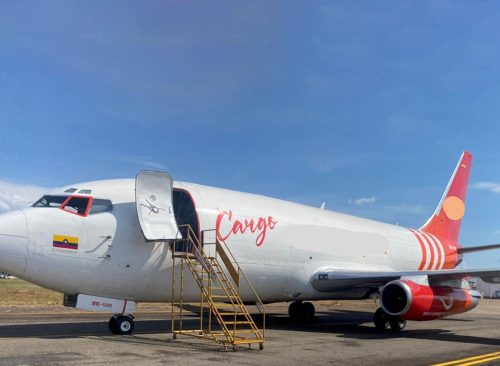Overweight Boeing Cargo Plane Narrowly Avoids Disaster After Clipping Tree on Takeoff
A Colombian jet was carrying too much weight when it took off at a dangerously low altitude, investigators said.

An overweight cargo jet clipped a tree on takeoff from an airport in Colombia last year, damaging an engine and forcing the plane to return to the airport, according to an investigation of the incident reported last week. The Aerosucre jet was carrying more than 600 pounds of extra weight when it struck the top of a 46-foot tree past the end of the runway at Colombia’s Puerto Carreno Airport on February 3, 2022. The takeoff was captured in the doorbell camera recording. The plane managed to return to the airport without any injuries but with damage to one of the jet’s engines. Here’s what you need to know about this near disaster.
What Was the Flight?

The jet was a Boeing 737-200 and carried a crew of five people when it took off on Puerto Carreno runway No. 7 on its way to the Colombian capital of Bogota. The crew was aware that the aircraft was 627 pounds heavier than its maximum takeoff weight, according to an investigation report. The weight of three aircraft occupants was omitted from the flight’s weight and balance computations, the report added.
What Happened
The aircraft took off at a low altitude and crossed just above wires, trees, and rooftops about 800 feet past the runway, according to the doorbell video. The jet struck at least one tree about 1,000 feet from the runway’s end. The jet’s left-hand engine overheated, emitted smoke and lost power, leaving the jet with only half of its thrust.
What Happened Next

The crew returned the aircraft to the airport after they restarted the left engine and climbed to 2,500 feet. The emergency landing took place about 20 minutes after takeoff. Inspectors later found that vegetation had entered the left engine and embedded itself in parts of the left wing.
What the Investigation Revealed

Colombia’s Aeronautica Civil investigation faulted the aircraft’s weight and weather conditions that “did not permit the aircraft to achieve a sufficient climb rate, climb angle and altitude to clear the obstacles in the takeoff trajectory.” High temperatures reduced air density, which hampered the aircraft’s ability to achieve lift.
“This weight together with the density altitude caused the aircraft to cover a longer takeoff roll distance consequently reducing the safety margin to avoid obstacles in the takeoff trajectory causing the aircraft to collide with a natural obstacle immediately after takeoff rotation and during initial climb,” according to an English translation of the Spanish-language report by The Aviation Herald.
RELATED: Alleged Killer Bryan Kohberger Only Meant to Kill One of the Victims Who He Was “Obsessed” With
What Else the Investigation Found

The investigation also concluded that crew complacency contributed to the incident. None of the crew members questioned the takeoff weight or ambient temperature or recommended waiting until the temperature dropped, which would have improved conditions for takeoff. The investigation also pointed out the incident’s similarity to the crash of an Aerosucre Boeing 727-200 in 2016.














